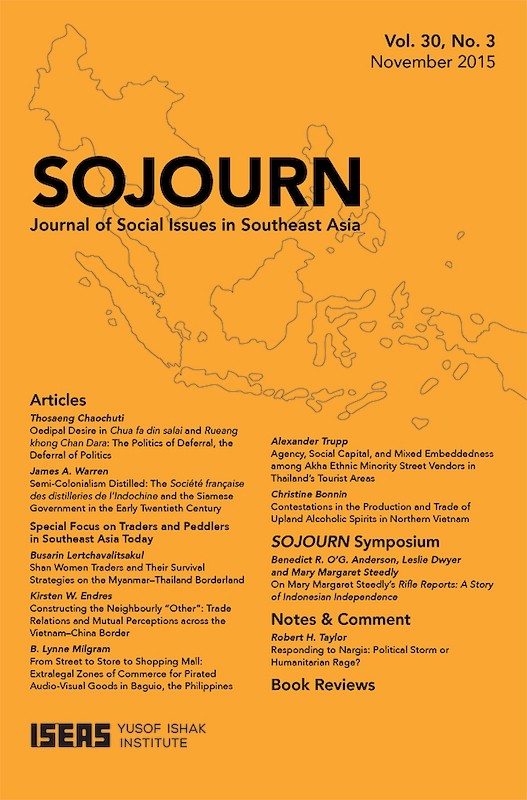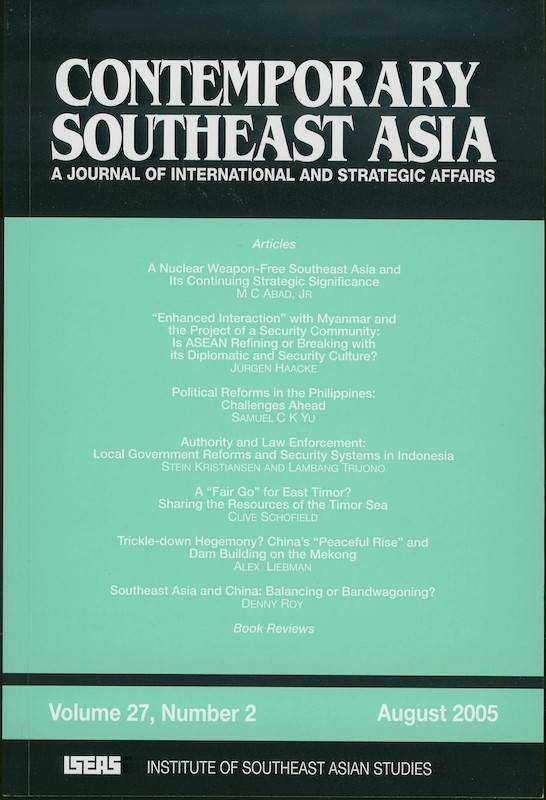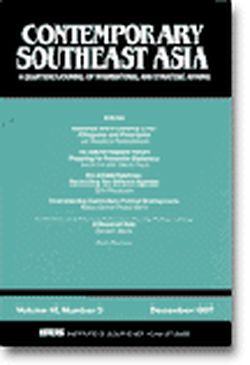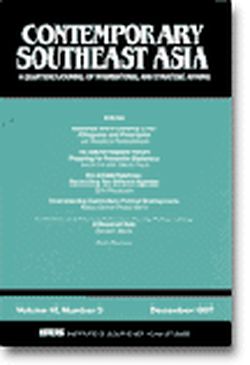Contemporary Southeast Asia Vol. 30/3 (Dec 2008)
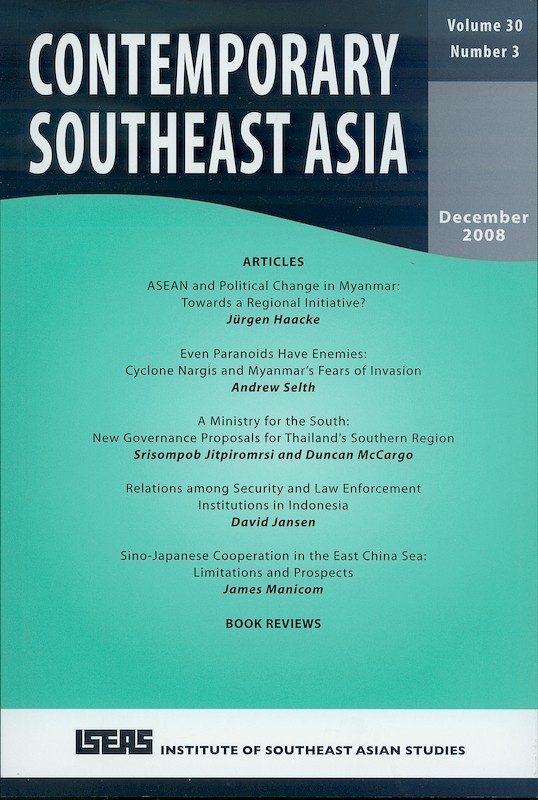
Date of publication:
December 2008
Number of pages:
147
Code:
CS30/3
Contents
-
Contemporary Southeast Asia Vol. 30/3 (Dec 2008)
[Whole Publication] -
Preliminary pages
- ARTICLES
-
ASEAN and Political Change in Myanmar: Towards a Regional Initiative?, by Jürgen Haacke, author see abstractASEAN states have favoured diplomacy and peer pressure in order to sway Myanmar's military regime to release Daw Aung San Suu Kyi and other political detainees and to promote national reconciliation. So far, ASEAN's combined efforts have not been very successful, although the generals are moving Myanmar beyond extra-constitutional rule. This paper asks whether, in the aftermath of the September 2007 protests, the constitutional referendum and Cyclone Nargis, there is much scope for a new regional effort to promote reconciliation and democratization in Myanmar that is additional to the support ASEAN offers for the good offices of the United Nations Secretary General. The paper sets out different positions held within ASEAN on promoting political change in Myanmar. It also examines the prospects for putting into practice recent ideas to address Myanmar's political situation in new regional settings. The paper concludes that: (1) significant difference characterize the Myanmar policy of individual ASEAN countries in line with varying interests and pressures, and dissimilar views on what if anything should be done to help Myanmar democratize; (2) Indonesia is the only ASEAN country to have conceptualized a possible regional diplomatic initiative, but its full implementation and success are far from certain.
-
Even Paranoids Have Enemies: Cyclone Nargis and Myanmar's Fears of Invasion, by Andrew Selth, author see abstractMost strategic analysts outside Myanmar dismiss an invasion of the country as a fantasy on the part of the military government, albeit one shared by some of its critics. In international relations, however, perceptions can be more important than objective facts. Fears of armed intervention by the United States, or a UN-endorsed coalition, have been strong influences on the ruling council's defence and foreign policies ever since the 1988 pro-democracy uprising. In that sense, the regime's heightened threat perceptions constitute a strategic reality that must be taken into account by the international community. As seen after Cyclone Nargis struck Myanmar in May 2008, failure to do so can make the delivery of humanitarian assistance, and the search for viable long term solutions to Myanmar's complex problems, much more difficult.
-
A Ministry for the South: New Governance Proposals for Thailand's Southern Region, by Srisompob Jitpiromsri, Duncan McCargo, authors see abstractThe ongoing conflict in Thailand's Muslim-majority southern border provinces has claimed more than three thousand lives since 2004. To date, successive governments have sought to control the violence mainly through the use of enhanced security measures, and by arresting and prosecuting insurgent suspects. Yet despite some limited successes in reducing the number of violent incidents, the underlying causes of the conflict have not been addressed. The Thai state suffers from a legitimacy deficit in the region, and many Malay-Muslims would like greater control over their own affairs. The insurgency is ultimately fueled by political frustrations. Yet all suggestions that the region might be granted some form of special administrative status have been consistently rejected by the authorities. This article examines proposals in a recent report by a team of Thai academics based in the region, who have advocated the creation of a new ministry to oversee the administration of the Deep South. These controversial proposals offer a compromise political solution, one which recognizes the distinctive nature of the region while preserving the core principle of a unitary Thai state.
-
Relations among Security and Law Enforcement Institutions in Indonesia, by David Jansen, author see abstractThe dominant perceptions of the academic literature on relations among security and law enforcement institutions in Indonesia tend to be negative. In part, academic works on the past behaviour of security forces in some of Indonesia's conflict areas inform the perceptions of the literature. Research on conflict zones often suggests that unclear boundaries of jurisdiction and poor internal command and control frustrated the efforts to coordinate security forces in such areas. While these conclusions may be accurate in places that are or were riven by high conflict, this article questions if such conclusions are accurate for the large parts of Indonesia that have only experienced low levels of security problems. The evidence presented in this article suggests that coordination and an effective division of labour does exist among government security agencies in a low conflict environment. This article outlines relations between the three primary law enforcement and security actors the National Police, territorial units of the Indonesian military and regional government in three district case studies in Yogyakarta. This article finds that while agencies at the sub-national level are highly autonomous, their autonomy does not present an obstacle for cooperation. In the case studies presented, government law enforcement and security actors acknowledge jurisdictional boundaries between one another. Where inter-institutional cooperation does take place, regional government plays an important, facilitative role. Despite this, the Indonesian police remain the lead agency in combating most threats to order and stability.
-
Sino-Japanese Cooperation in the East China Sea: Limitations and Prospects, by James Manicom, author see abstractIn June 2008, Japanese and Chinese media reported that a breakthrough had been reached in the four-and-a-half year Chunxiao gas dispute. Rumours that an agreement was imminent had been circulating since early 2008 and had gained momentum during Hu Jintao's historic visit to Japan in May. The breakthrough followed eleven rounds of director-general level discussions, and several ministerial and executive level meetings. The elite commitment to arrive at a consensus emerged after a period of significant tension in the bilateral relationship. Given this turn around in bilateral relations, the process by which the "new consensus" emerged merits investigation as it may hold lessons for Sino-Japanese relations as a whole. In an effort to explain the circumstances of the June agreement and analyse what lessons it holds for the Sino-Japanese relationship, this article is divided into three sections. The first section explores the background of the Chunxiao gas dispute in an effort to understand what is at stake in the dispute and the barriers to compromise. The second section analyses the breakthrough in June. The final section discusses the prospects and barriers to future cooperation. The article concludes with an assessment of what lessons can be learned from the agreement.
- BOOK REVIEWS
-
BOOK REVIEW: Conflict, Violence, and Displacement in Indonesia. Edited by Eva-Lotta E. Hedman., by John Virgoe, author
-
BOOK REVIEW: Pacific Asia: In Quest of Democracy. By Roland Rich., by Erik M Kuhonta, author
-
BOOK REVIEW: Promoting Human Rights in Burma: A Critique of Western Sanctions Policy. By Morten B. Pedersen., by Tin Maung Maung Than, author
-
BOOk REVIEW: The Political Economy of Regionalism in East Asia. By Hidetaka Yoshimatsu., by Stephen Hoadley, author
-
BOOk REVIEW: Singapore in the Global System: Relationship, Structure and Change. By Peter Preston., by Ho Khai Leong, author
-
BOOK REVIEW: Asia's New Regionalism. By Ellen L. Frost., by John Miller, author

